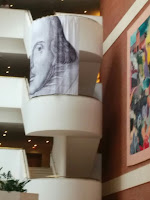LIS 580 British Studies
The British Library
June 8, 2016
Kevin Mehmet was our charming host today. He was a font of information about the inner workings and history of the British Library, as well as some solid Information Science wisdom. The British Library serves as the National Library of the United Kingdom. It receives a copy of every book published in the UK and Ireland. The Library's goal is to 1. collect the published output of the nation, 2. keep and preserve the collection, and 3. make the collection available to researchers. Its further responsibility is to provide leadership to the library community and commission research.
The collection is not accessible to the general public. In order to read its books you must register as a Reader. Along with two forms of identification you must come armed with a bibliography of the item(s) you wish to read.
The British Library is a legal deposit library, which means that by law it must receive a copy of everything published in the UK. That is 8 thousand items a day which translates to 8 miles of shelf space per year. Most of the collection is stored in an environmentally controlled tower beneath the library. Part of that increasing collection is stored offsite in their Boston Spa property in West Yorkshire.
The St. Pancras location, which we visited was opened officially in 1998. The lobby (as seen above) was intended to make a visitor feel uplifted. Designed by architect Sir Colin St John Wilson and his partner MJ Long, the whole building has a nautical theme. There are portholes and the hallway layout is that of a ship. The architect insisted that American Oak be used because its color will not fade. It has been listed as a Grade 1 historical building.
Hans Sloane is one of the worthies whose bust is displayed on the left wall of the lobby atrium. One of the founding fathers of the British Museum and Library, his donated book collection helped to provide a cornerstone for the British Library Collection. He bequeathed the collection to the nation for “the improvement, knowledge, and information of all persons.” He was a traveler, philosopher, and naturalist. Aside: he brought cocoa from the Americas and added milk and sugar to create the delicious chocolate we eat today.
The British Library separated from the British Museum in 1973. It took them 4 years to move the (then) 30 million item collection. Having been part of the greater British Museum, it retains some 8.25 million non-book items in its collection. It holds the Tapling stamp collection as well as an extensive collection of WW1 postcards that were on display on the first floor while we were there.
The library is organized using a unique cataloging system for their collection. Here we find that there is a geographic place for everything; a "forever home". As a government deposit library, they do not weed their collection and every book has a permanent address. A very small part that is a browsing collection located in some of the reading rooms is cataloged using the Dewey Decimal system.
Behind the scenes, Kevin showed us the Mechanical Book Handling System and the Automated Book Retrieval System that enables staff to move requested books from their location in the stacks to the readers that requested them in the reading rooms. Once ordered, staff can retrieve a book in approximately 70 min.
This glass tower contains The King's Library. King George III was an avid book collector and his collection was donated to the British Library. The architects designed this glass tower to feature and display the King's Library that continues to be used by researchers in the greater Library, but is kept apart as an individual set.
After our guided tour we viewed the Treasures of the British Library Exhibition. We saw handwritten Beatle's lyrics, the St. Cuthbert's Gospel (the oldest book in the U.K.), THE Magna Carta, copies of Utopia and Beowulf, and Jane Austen's drawings. There is a computer display that lets you virtually handle a copy of a Source Bible as well as other ancient and priceless manuscripts.
 Memorable Non-sequitur: Kevin saying "You should trust me. I'm a librarian I know everything." He also taught us some British slang. A "boffin" is someone very clever, like a scientist. We know that "posh" is to be fancy (thanks Spice Girls). And to have a "barney" is to have a fight or heated argument.
Memorable Non-sequitur: Kevin saying "You should trust me. I'm a librarian I know everything." He also taught us some British slang. A "boffin" is someone very clever, like a scientist. We know that "posh" is to be fancy (thanks Spice Girls). And to have a "barney" is to have a fight or heated argument.Shakespear in Ten Acts
The Shakespear in Ten Acts Exhibition was an interesting display of Shakespearean manuscripts, art, music, film, and costumes.
This exhibition was fascinating. Dividing Shakespear's plays into ten acts and delving deeply into his motivations and development as a writer, this display was colorful and varied. It used audio and film to draw you from one act to the next. The different epochs of his life and writing that the exhibition focused on, continued to stay with me. We were able to see some of the original beautiful costumes used in performances from the 20th century. The sheer breadth of Shakespeare on film made me want to go hide somewhere and consume all the iterations.
Movie to Watch: Twelfth Night (with Stephen Fry)








Comments
Post a Comment